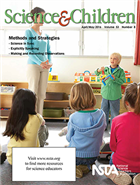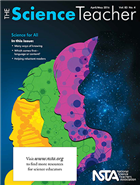Calls for Papers for NSTA Journals
By Korei Martin
Posted on 2016-05-25
 Do you have a great science teaching idea you want to share with peers? If so, consider writing for NSTA’s journals. Calls for papers for NSTA’s science education journals are online. The NSTA journals cover all grade levels, so no matter which grade level you teach or would like to write for, NSTA has you covered. Each journal does have its own set of guidelines, so please look them over in the author guidelines section before you submit your proposal. Getting your article published in a peer-reviewed NSTA journal looks great on your c.v. so don’t wait, enhance your career today. Below are calls with approaching deadlines, and more are available online.
Do you have a great science teaching idea you want to share with peers? If so, consider writing for NSTA’s journals. Calls for papers for NSTA’s science education journals are online. The NSTA journals cover all grade levels, so no matter which grade level you teach or would like to write for, NSTA has you covered. Each journal does have its own set of guidelines, so please look them over in the author guidelines section before you submit your proposal. Getting your article published in a peer-reviewed NSTA journal looks great on your c.v. so don’t wait, enhance your career today. Below are calls with approaching deadlines, and more are available online.
 Call for Papers: Science and Children
Call for Papers: Science and Children
April/May 2017: Matter and its Interactions (NGSS: PS1)
Deadline October 1, 2016
Although the NGSS identifies an end point in grade 8 as understanding that all substances are made of about 100 different types of atoms that combine in different ways, the concept of atoms is not introduced in grades preK–5. However, there is a great deal of knowledge concerning matter that can be introduced and developed during these years. This base of learning provides the scaffolding needed to continue to develop an understanding of atoms as this core idea is introduced in middle school. Understanding matter and its interactions can begin in early years with investigating observable properties of materials through analysis and classification.The fifth grade development of this core ideas focus on structure and properties of matter and chemical reactions and ends just short of investigating nuclear processes and the structure of particles that are unseen.
- Describe investigations concerning the concept that materials are similar and different from one another. Explain how students measure or quantify the similarities and differences.
- Identify strategies to support the concept that properties of the materials relate to their use.
- Explain types of experiences students have in the use of a variety of materials to create working models.
- Provide investigations involving changes matter undergo through heating or cooling.
- Illustrate how students experience creating and analyzing new substances by mixing two or more different substances.
 Call for Papers: Science Scope
Call for Papers: Science Scope
March 2017: Our Sun and Beyond the Solar System
Submission deadline: October 1, 2016![]()
Most students are fascinated with astronomy; the intersection between astronomy, mathematics, and mythology mark it as unique among the sciences. A total solar eclipse will occur from America’s coast to coast on August 21, 2017. Millions of people will be witness to this event, which lends itself to numerous explorations that are sure to get your students excited. Why not take advantage of this rare phenomenon to inspire your students while addressing the following performance expectation: Develop and use a model of the Earth-Sun-Moon system to describe the cyclic patterns of lunar phases, eclipses of the Sun and Moon, and seasons (MS-ESS1-1). Tell us how your students:
- Use models to investigate phenomenon and movement related to planetary objects
- Use investigations to convey safety procedures regarding observing the eclipse
- Use models and data to investigate topics beyond our solar system
- Understand how scientists use technology to observe and study the Sun
 Call for Papers: The Science Teacher
Call for Papers: The Science Teacher
Eclipse!
SUBMISSION DEADLINE: October 1, 2016
On August 21, 2017, a rare total eclipse of the Sun will cross the United States from Oregon to South Carolina, passing through Idaho, Wyoming, Nebraska, Kansas, Missouri, Kentucky, Georgia, and Tennessee along the way. Do you teach about eclipses and other astronomical events? Have you found ways to get your students excited about this upcoming eclipse? Have you discovered useful teaching resources? If so, why not share them with TST readers?
Engaging in Argument from Evidence
SUBMISSION DEADLINE: October 1, 2016
The Next Generation Science Standards point out that scientific knowledge is based on empirical evidence. Students “should have instruction that emphasizes why explanations are based on evidence,” and be expected “to use argumentation to listen to, compare, and evaluate competing ideas and methods based on their merits … using evidence to evaluate claims.”
- What strategies have you used to support argumentation in your science classes? Are your students provided with opportunities to recognize “bad science” and false claims in the media?
- What techniques do you implement to engage students in constructively critiquing their own argument and those of their classmates?
Learn more about NSTA journals.
The mission of NSTA is to promote excellence and innovation in science teaching and learning for all.
Future NSTA Conferences
2016 Area Conferences
2016 National Conference
Follow NSTA
Disclaimer: The views expressed in this blog post are those of the author(s) and do not necessarily reflect the official position of the National Science Teaching Association (NSTA).

